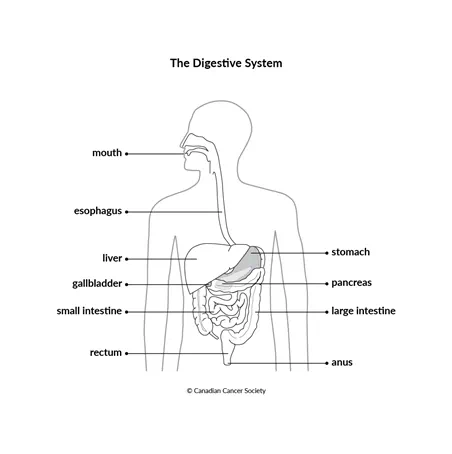What is pancreatic cancer?
Pancreatic cancer starts in the cells of the pancreas. A cancerous (malignant) tumour is a group of cancer cells that can grow into nearby tissue and destroy it. The tumour can also spread (metastasize) to other parts of the body.
The pancreas is an organ in your abdomen. It is shaped like a slim pear and is about
as long as your hand. It is a part of both the

Cells in the pancreas sometimes change and no longer grow or behave normally. These changes may lead to non-cancerous (benign) tumours such as serous cystic neoplasms (SCNs) or pseudocysts.
Changes to the cells of the pancreas can also cause precancerous conditions. This means that the abnormal cells are not yet cancer, but there is a chance that they will become cancer if they aren't treated. The most common precancerous condition of the pancreas is pancreatic intraepithelial neoplasia (PanIN).
But in some cases, changes to pancreatic cells can cause pancreatic cancer. Pancreatic cancer usually starts in exocrine cells called ductal cells, a type of epithelial cell that lines the inside of the pancreatic ducts. This type of cancer is called adenocarcinoma of the pancreas or pancreatic ductal adenocarcinoma.
Rare types of pancreatic cancer can also develop. These include sarcoma or adenosquamous carcinoma of the pancreas.
Another rare type of tumour can start in endocrine cells of the pancreas. These types of tumours are called pancreatic neuroendocrine tumours (pNETs). Depending on how different the cells are from normal cells (called differentiation) and how fast the cells are growing (called grade), pNETs can be classified as precancerous or cancerous. A cancerous pNET is called pancreatic neuroendocrine carcinoma. Find out more about pancreatic neuroendocrine tumours (pNETs).
Other types of cancer can spread to the pancreas, but this is not the same disease as primary pancreatic cancer. Cancer that starts in another part of the body and spreads to the pancreas is called pancreatic metastasis. It is not treated in the same way as primary pancreas cancer.
The pancreas
Cancerous tumours of the pancreas
Precancerous conditions of the pancreas
Non-cancerous tumours of the pancreas
Your trusted source for accurate cancer information
With support from readers like you, we can continue to provide the highest quality cancer information for over 100 types of cancer.
We’re here to ensure easy access to accurate cancer information for you and the millions of people who visit this website every year. But we can’t do it alone.
Every donation helps fund reliable cancer information, compassionate support services and the most promising research. Please give today because every contribution counts. Thank you.
